HarmonicDyne x Z Reviews Eris HiFi Headphones – Embrace The Bloom
HarmonicDyne Eris is a $249 USD pair of Hifi Headphones with an over-the-ear design, new earpad and headband mechanism and a large dynamic driver to punch you with a big bass and a strong kick. Coming with a high-end cable too, the Eris will be put up against other similarly priced headphones, including Aune AR5000 (299 USD), Dekoni x HIFIMAN Cobalt (399 USD), and Sivga Luan (359 USD)
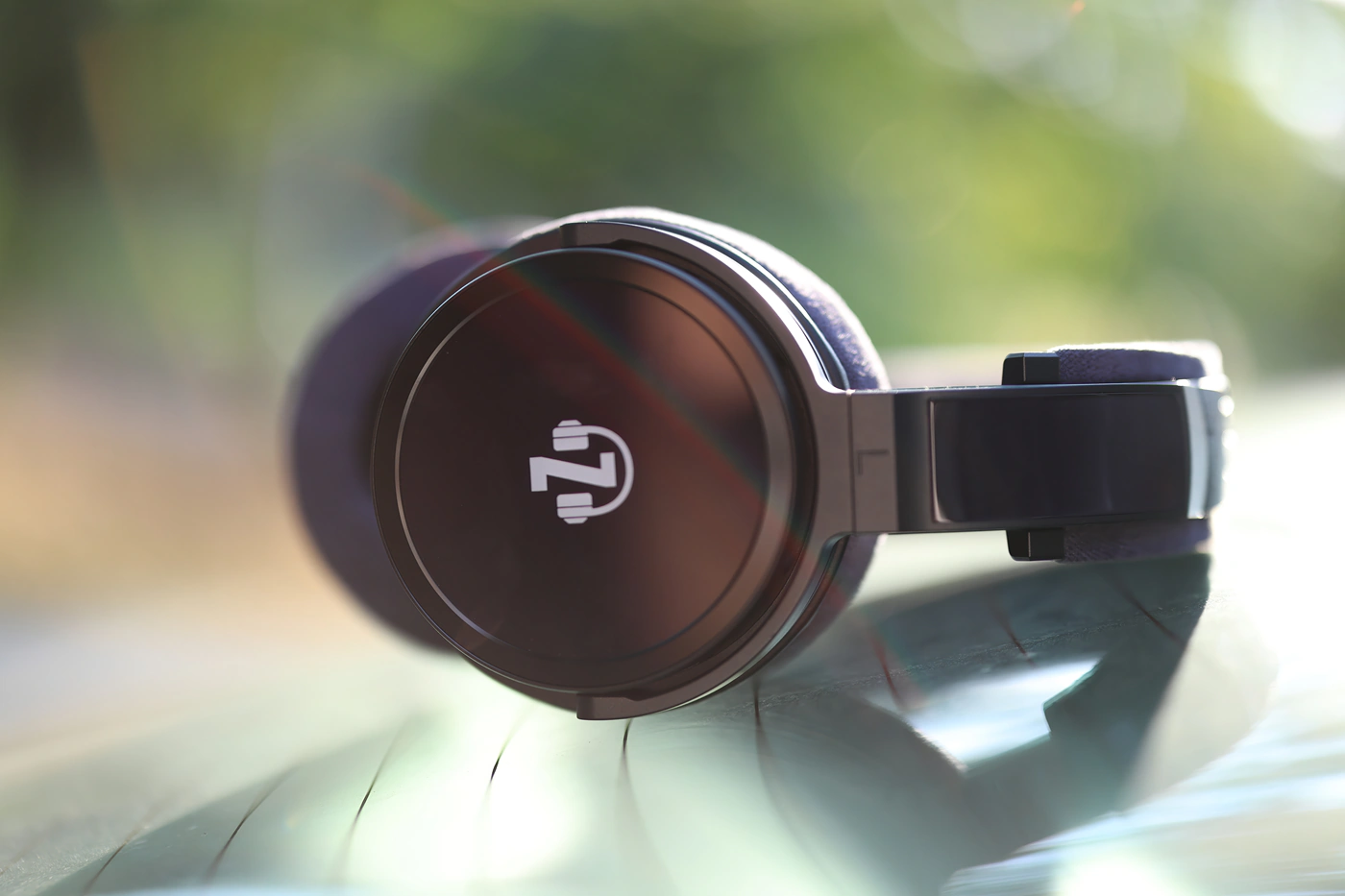
Introduction
HarmonicDyne is a company mainly sold and fulfilled by Linsoul, one of the biggest and most popular shops for purchasing Chifi headphones and IEMs. Linsoul is right now the largest Chifi shop when it comes to IEMs and Headphones, but they also sell their products through Amazon, for you to have access to both the excellent Linsoul support and Warranty, but also Amazon’s extended return policy. As an Amazon Influencer, I earn from qualifying purchases, and using the purchase links in my reviews helps me maintain this website and Youtube Channel. Huge thanks to Linsoul for providing the sample for this review, in exchange for my honest opinion.
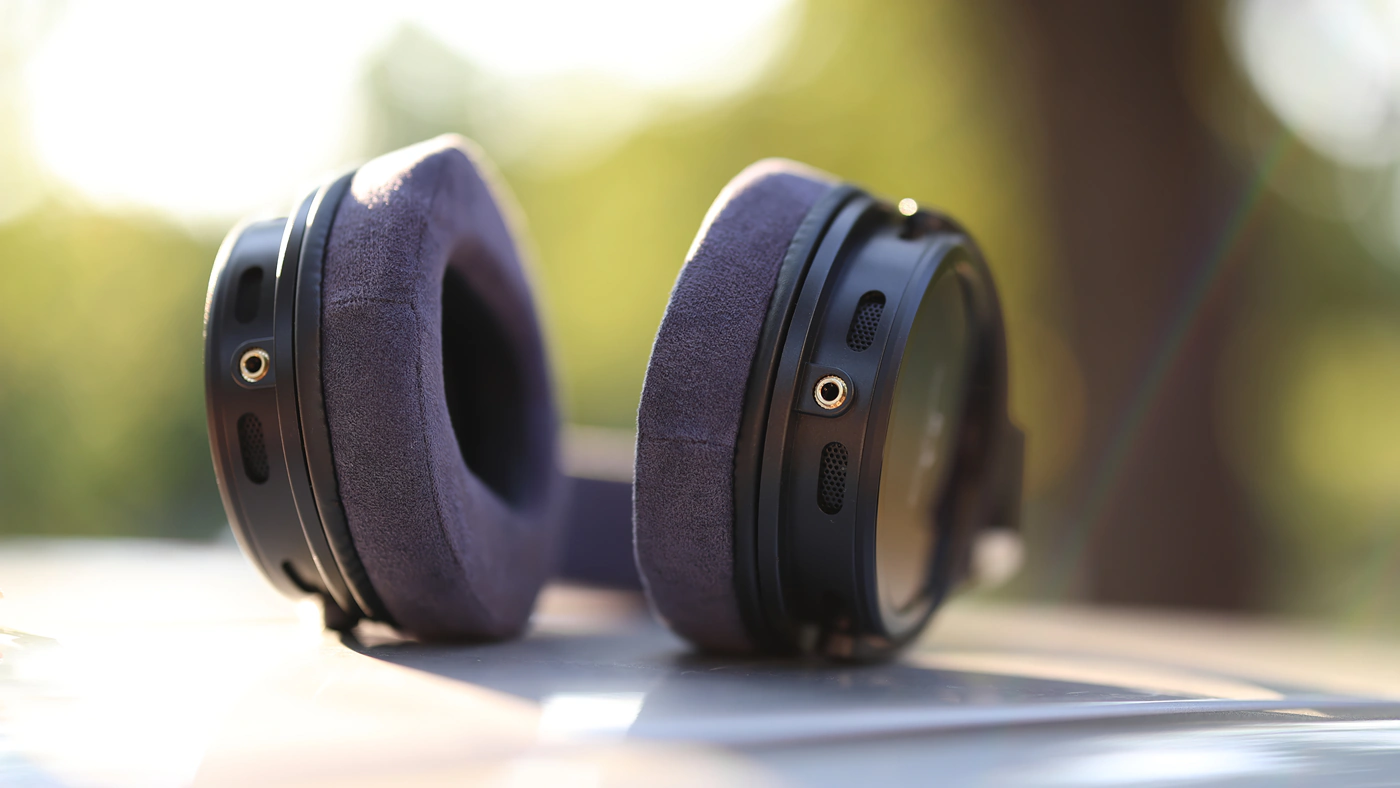
PROs – Lightweight build, beautiful design, great ergonomics with soft and large earpads, very little leakage, strong and deep bass, revealing sound and strong details, fun overall presentation that is easy to listen to and enjoyable. Very easy to drive and it is consistent across multiple sources.
Cons – Almost no passive noise isolation.
Product Link
Amazon – https://amzn.to/3MmLzUr
Aliexpress – https://s.click.aliexpress.com/e/_DFwATUx
Build Quality/Aesthetics/Fit/Comfort
HarmonicDyne Eris is the kind of headphone that looks really beautiful in person, having those glassy earcups, and a large 50mm dynamic driver at the heart. The tuning has been changed from other HarmonicDyne headphones, so it is interesting to see that the company included a high-end cable too. The driver is described as a latest generation Ceramic-Metal High-Flux Magnetic long-Stroke Dynamic Driver or CMHFMLS-DD. The driver membrane or diaphragm is a ceramic-metal infusion diaphragm, and it has a high tensile strength from micron-thin metal sheets and the rigidity of ceramic layering, to achieve greater rigidity than typical driver membranes.
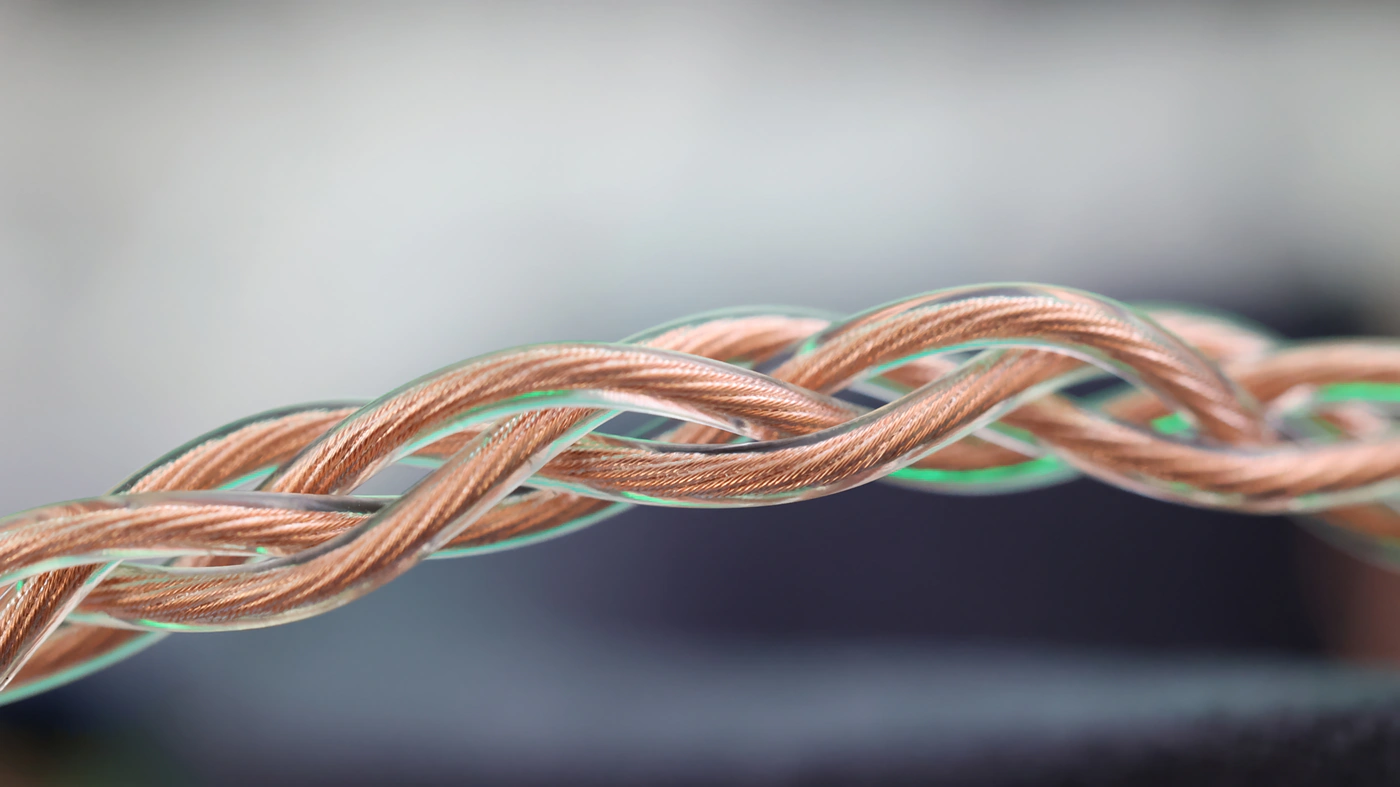
When it comes to the passive noise isolation, we have a semi-open or semi-closed back design, as you will se ventilation on the earcups, right where the yolk couples to the headphone earcups, and those ventilations are very large in size, making the Eris a headphone that allows most of the sound that is being played on the inside to pass through only very slightly, and also offering minimal passive noise isolation, around 5 dB. I have to bring the volume quite loud to avoid the noise of myself typing being too strong, but this means there is no void or driver flex when using the Eris. People around you will know you’re listening to music, but they won’t hear much of it, even at very loud volumes, the sound being audible to the outside being minimal.
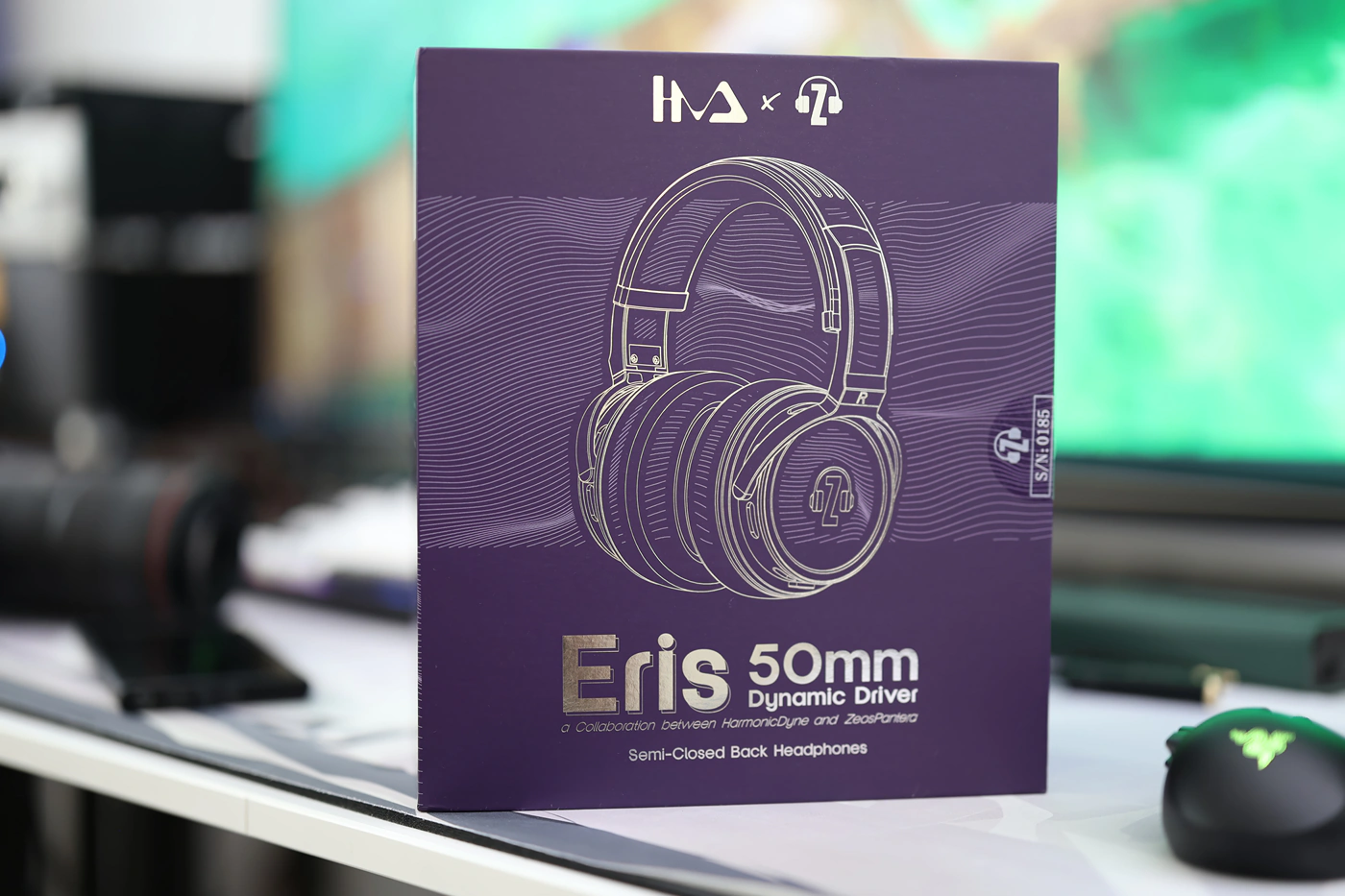
Different from all the other HarmonicDyne Headphones, Eris has unique ear pads made with softer materials and featuring their own Light Blue micro-suede fabric and vegan leather design to achieve better airflow and comfort in both cool and hot environments. While the new earpads are indeed very comfortable, they make a sound while moving, which happens for around 5 minutes after placing them on, while they are breaking in and warming up. The new earpads are also loosely connected to the headphones, and can almost freely turn around their own axis, so you have to arrange them when putting on the headphones.
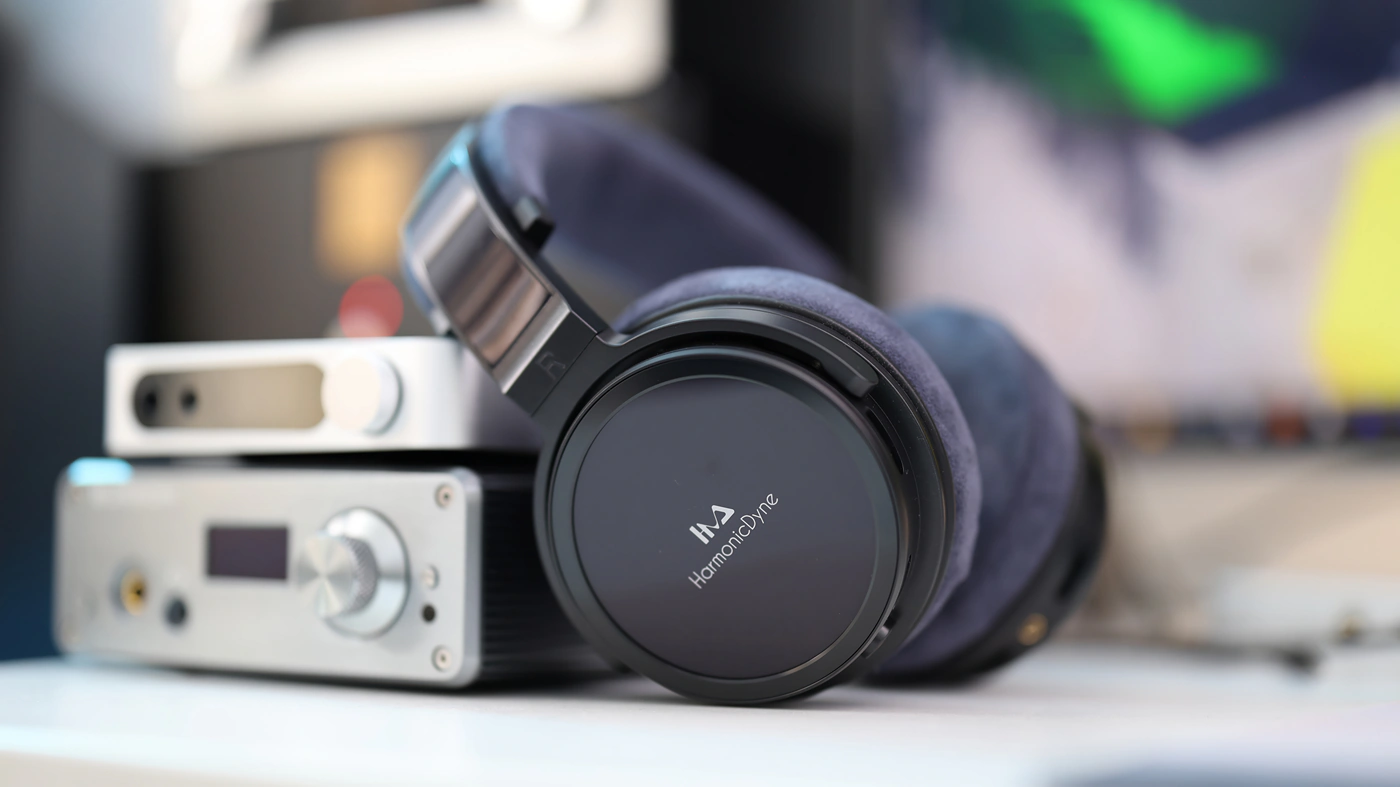
The headband and headphone materials are mainly molded plastic, glass and aluminum, but Eris ends up being one of the lightest headphones I have reviewed, and at 320 Grams without the game, they feel super comfortable for walking, sitting at the computer or even dancing. The advantage here is that the headband also has that soft material and there is no hotspot of pressure, while clamping force is medium, so no discomfort at the ear level either. Because the adjusting mechanism is almost at maximum on my medium head, I fear that Eris won’t be the most comfortable headphone for someone with a larger head.
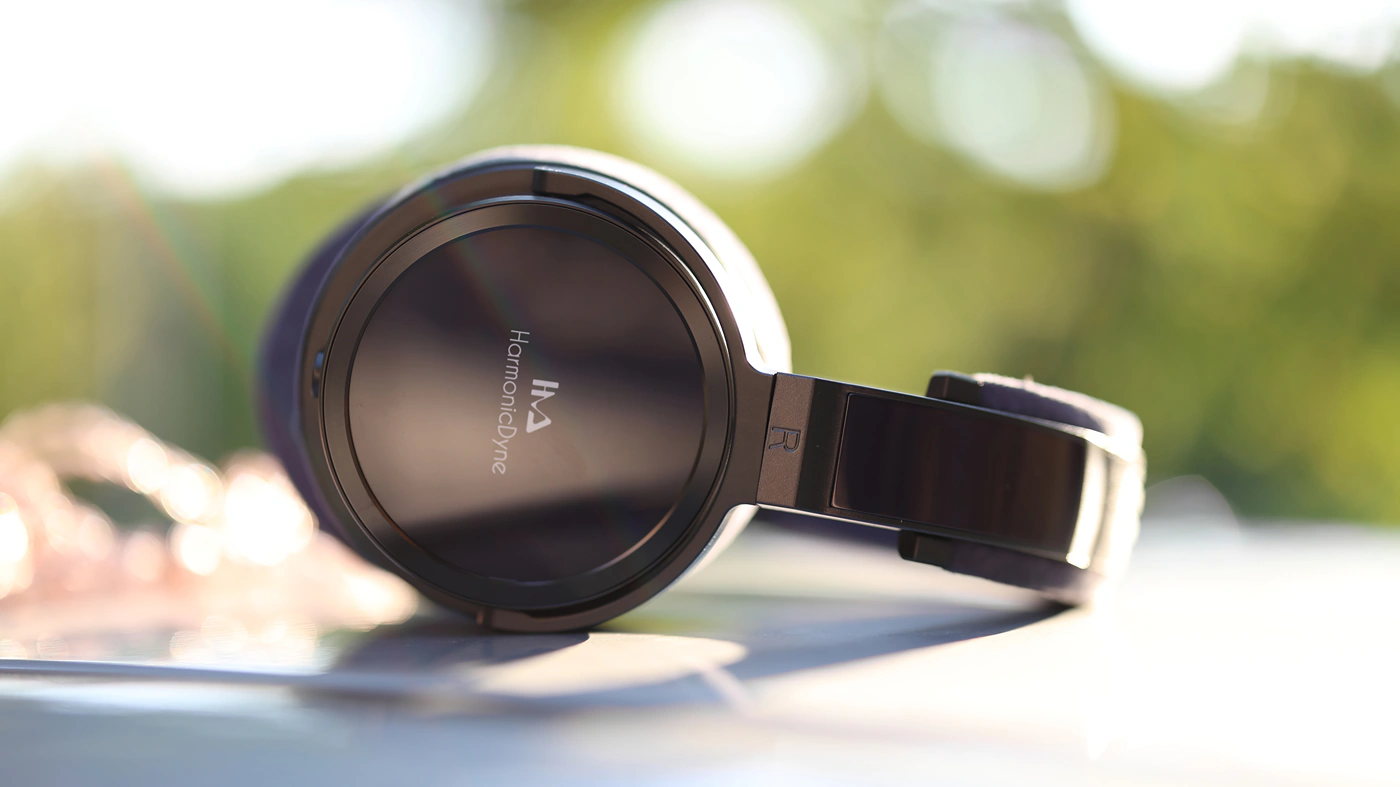
Every Eris pair of headphones will come with a 4.4mm balanced cable, and while there are even better aftermarket options like LavriCables Master Silver, the default cable of the Eris is one of the best if not the best default cable included with a headphone in this price range. The internal construction uses solder-tuned single crystal copper wires, and it is easily replaceable, as the connectors at the headphone side are 3.5mm standard connectors, so cables from HIFIMAN Arya Organic, or even ddHIFI BC150B will work just fine. The default cable has absolutely zero microphonic noise, it is so high-quality and silent that I would purchase Eris just to use the cable with a high-end headphone like HE1000SE. I am genuinely hopeful HarmonicDyne will offer the cable for sale at a good price, I am sure it would be super popular.
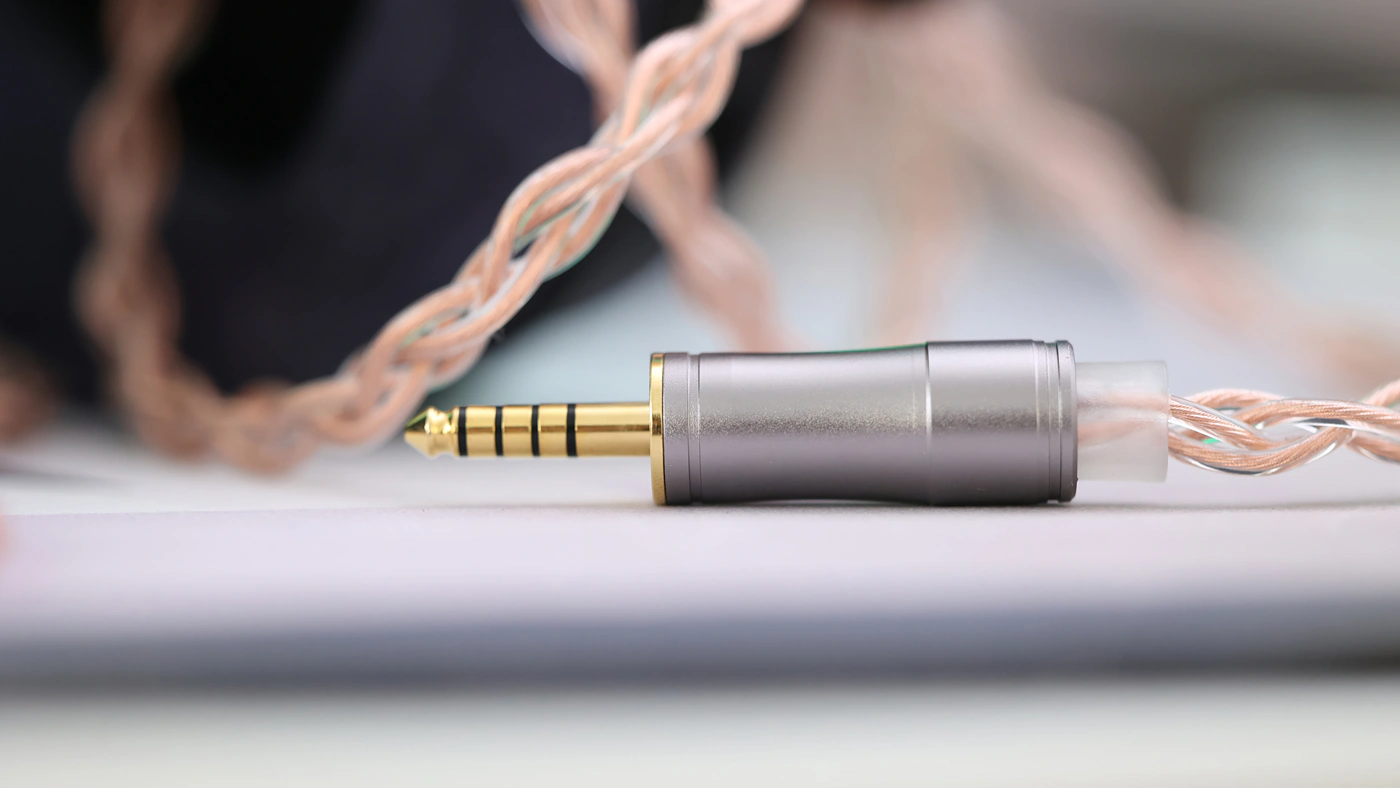
While I can understand the enthusiasm of the company, I saw on the official page that because the headphone has symmetrical connectors you could theoretically use them backwards and reverse the left and the right channels, but I think they allowed their enthusiasm to influence the marketing materials a bit much, as this won’t result in a good sound. HarmonicDyne also states that Eris needs 50 hours of burn-in to achieve the final sound, and that the earpads will squeak and make some sounds when moving, but this should disappear after 10 hours of usage. In my experience that noise is caused by the internal sponge, but it gets better with time.
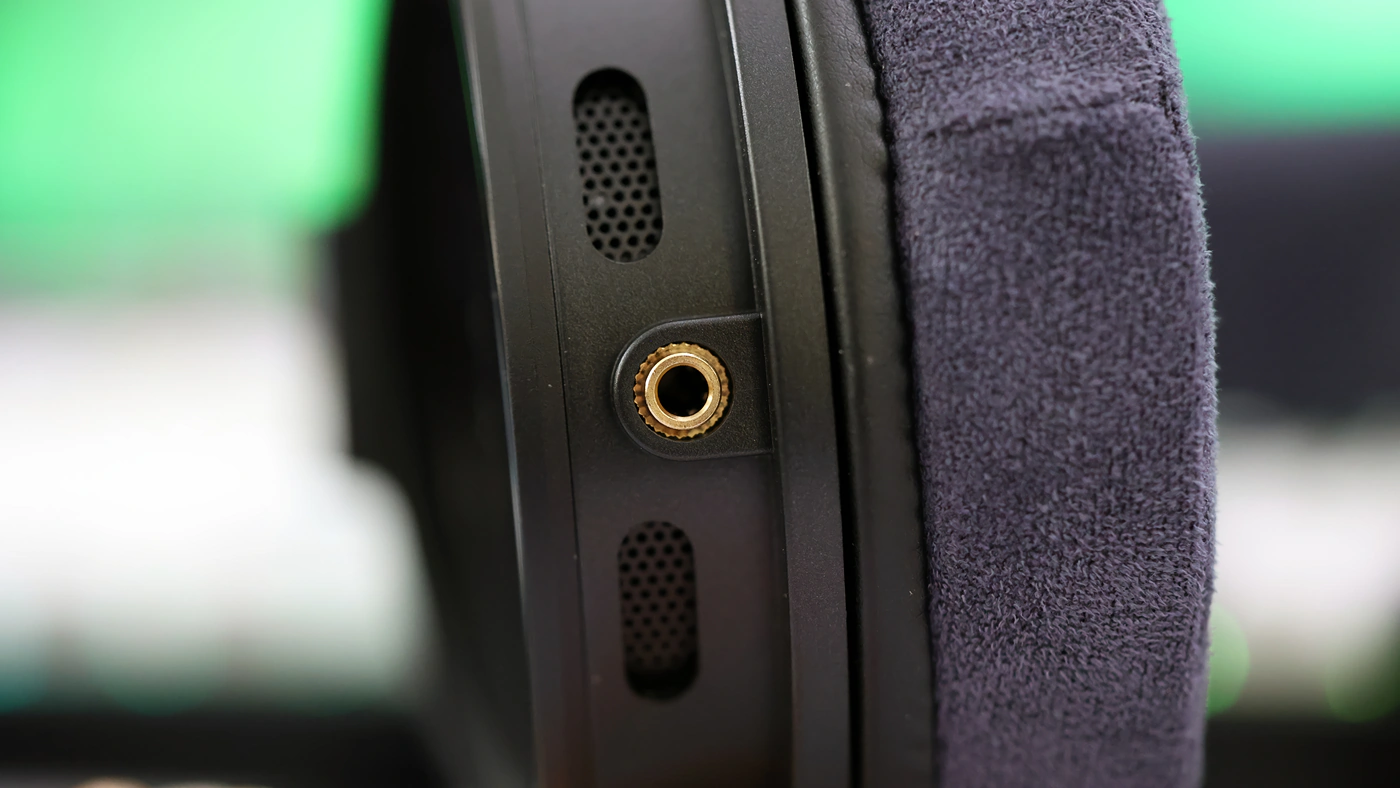
The impedance of the Eris is 32 OHMs, which is very good, but the SPL is incredibly high at 118 dB / Vrms, almost the highest of any over-the-ear headphone I have reviewed and heard to date. With a cable length of 1.5 meters, and a THD of <2%, I have given Eris a strong chance to shine with a multitude of sources, including Musician Pegasus II R2R DAC driving HIFIMAN Prelude for the Amplifier, KAEI TAP-1 Hifi DACs, iBasso D16, iBasso DX320 MAX Ti, Topping A50 III driven by Topping D50 III, FiiO K11 R2R, Dethonray Listening M1, and Hiby R4 Music Player. HarmonicDyne x Z Eris is way easier to drive than most headphones, but happily it is not sensitive to source noise and I can’t hear any kind of hissing or background noise, but they get super loud easily, and will sound good with most sources, being rather consistent across multiple sources. Due to their warmer, thicker and lush sound, I would pair the Eris with neutral and sharp sounding sources, or very detailed sounding sources, so iBasso D16, and the Topping stack both work really well.
Sound Quality
Overall Signature – Eris is a bloomy, deep and full sounding headphone with a full bass, lots of weight to each musical note, and a strong dynamic range. There’s a good sense of space and depth to the sound of the Eris. There is some variation with volume, as Eris sounds best at higher volumes, where it gets more balanced, and the treble becomes brighter and more forward, getting more punch and energy in contrast to the midrange and the bass, resulting in a more balanced tuning. This being said, the sound is smooth and full more than it is technical, Eris never gets fatiguing or harsh, but the 0.2% THD is audible in the bass, especially with heavy tracks, where you will hear a lot of bass texture.
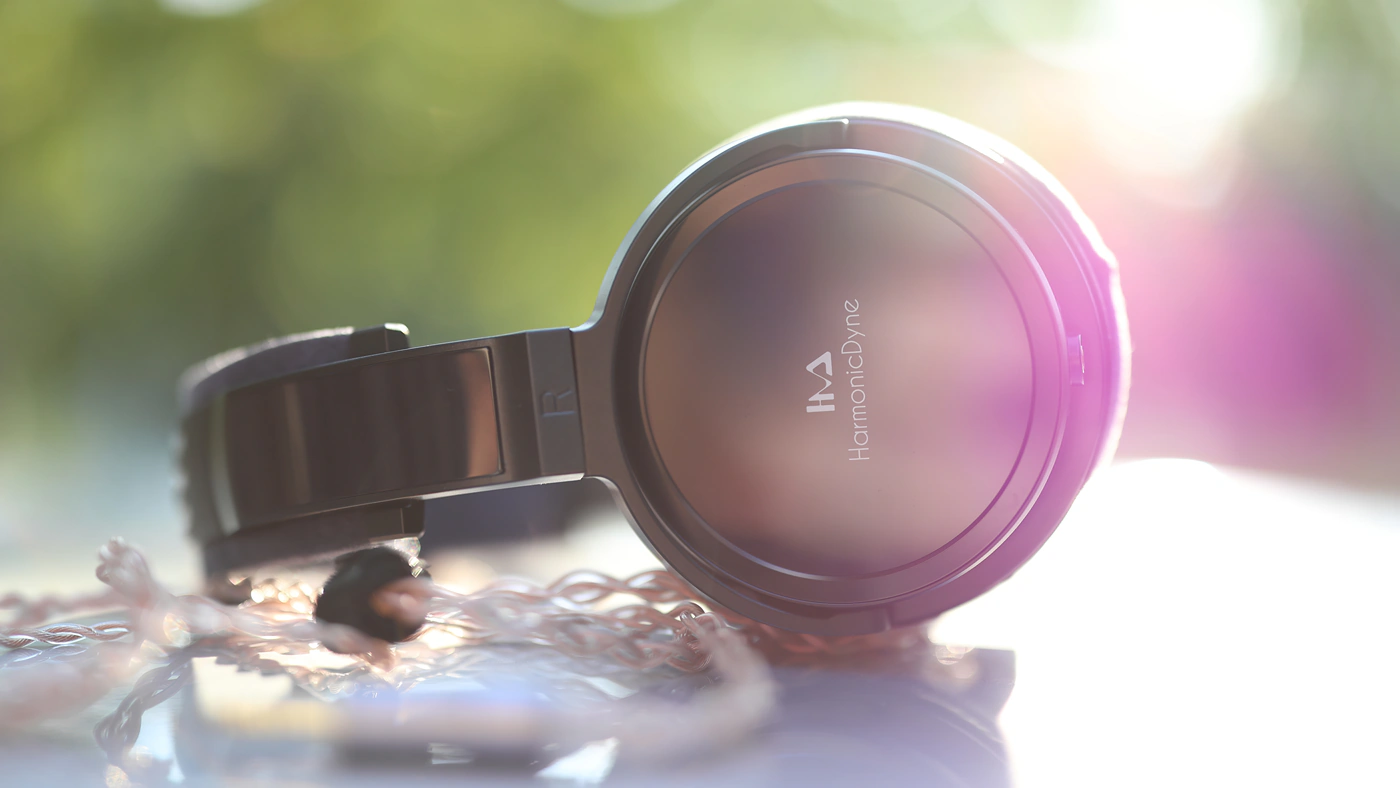
Bass – Starting from a beefy low-end, bloom and boom is in full force with the Eris, as they have a really deep and punchy bass that touches 20 Hz easily, and has most strength / power starting from 20 Hz, all the way to 120 Hz, resulting in a fairly strong bottom end and satisfying sound. All instruments, textures and effects are dominated by this powerful bass, and you will hear it everywhere, even square waves, electronic instruments, everything has a bit of extra bloom and thickness, weight and substance, low-end resonance to it. At very high volumes, bass gets very textured, which feels detailed, and you hear the differences between different bass types and styles. An interesting side effect is that most songs sound like they are bass heavy, including lighter pop like Hime Hina, while super heavy songs really give you a vibration massage on your head and you hear all the bass without heavy distortion or clipping, resulting in a pleasing tuning.
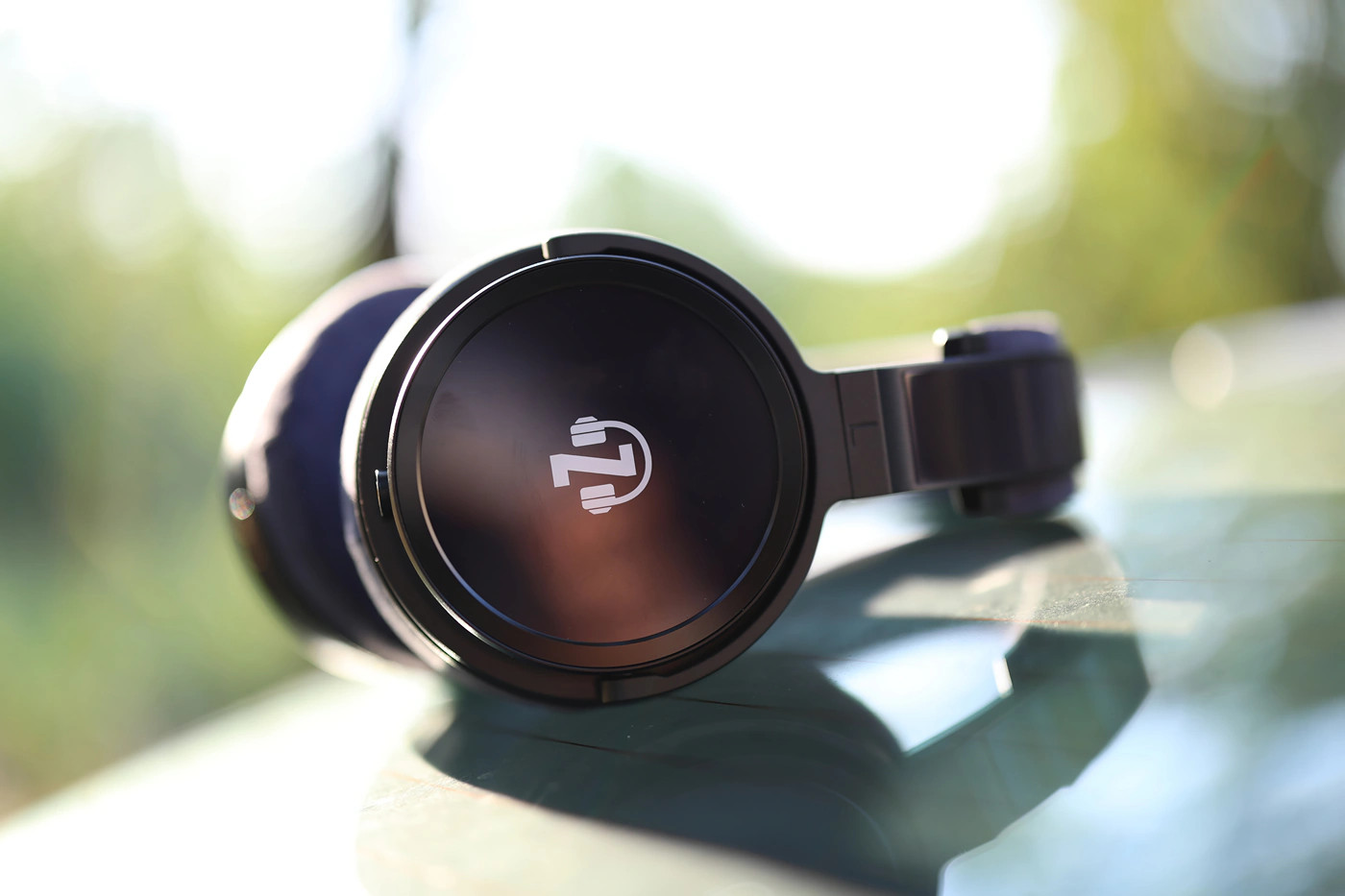
Midrange – Mids are smooth, full, lush and thick sounding, with male voices sounding deep and full, while female voices are bright and brilliant. There is a V-Shaped tendency for the midrange, having a strong presence in both the lower midrange and the upper midrange, but avoiding the 1 kHz peak that makes sound plasticky. Multiple layers of female voices sound sweet and pleasing, well defined and well separated, while stereo imaging is fairly accurate. Eris is not made for guitars and rock in general, sounding best with commercial music, pop, EDM, Dubstep and Rap, breathing life and energy into those styles, and with the heavy bass giving them a lot of excitement, Eris sounds engaging and fun, full and warm, with a pleasing tonality for all songs played through it. Even something a bit more exotic including violins or trumpets sound smooth and fun, colorful and vivid rather than fatiguing or too textured.
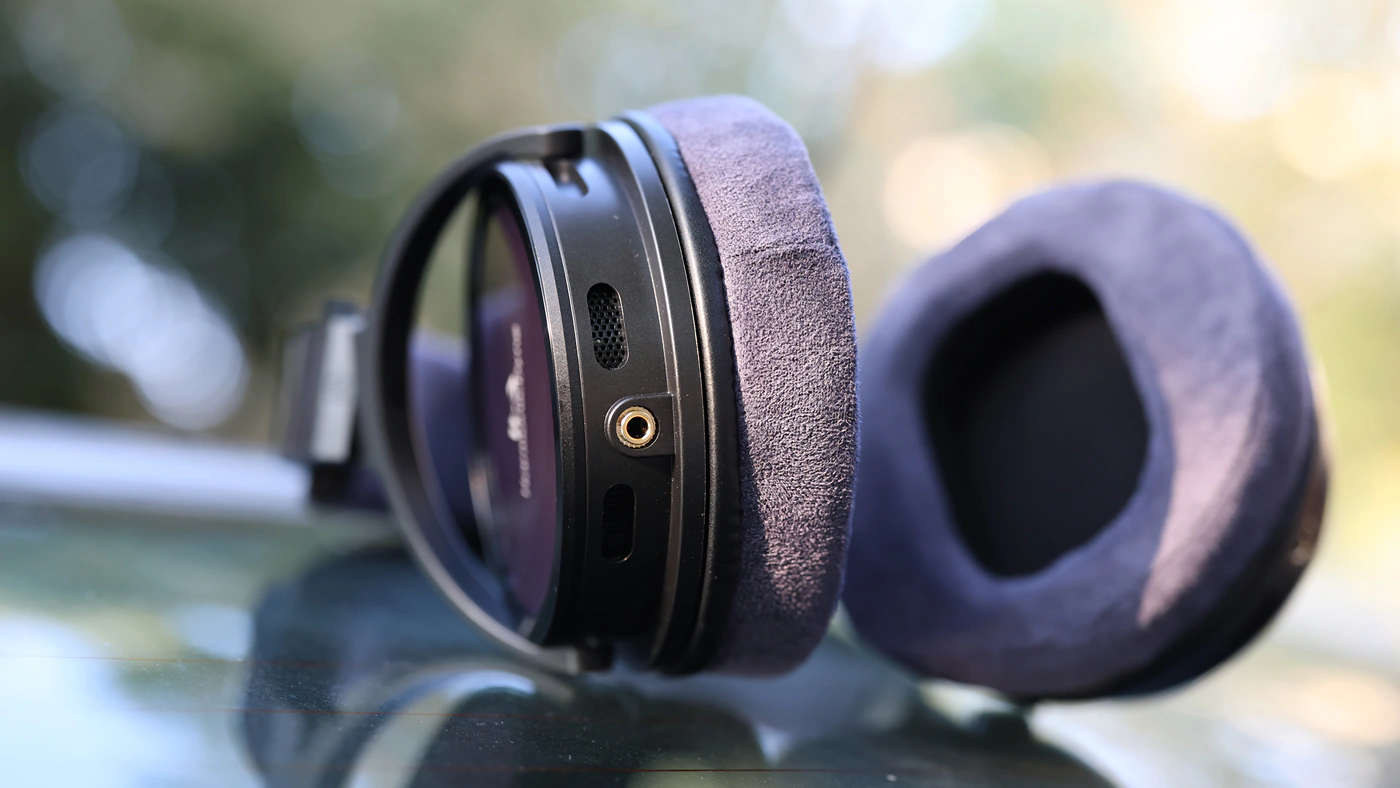
Treble – The treble of Eris is bright and sharp when really asked to present itself, but stays far behind the bass and somewhat in line with the midrange for most tracks. While metal and rock will have a sharp and bright treble, strong cymbal crash sound, I cannot hear the treble as intrusive or too much in the mix with pop, EDM, and electronic music. It feels like the open back and internal space of the Eris re-creates the treble sound a bit forced for rock and metal, where it enhances resonance and reverberation a lot. For pop and electronic music, this sounds like a wide soundstage, pleasing separation and good detail, but in rock and metal, if the song is bright, the treble can get aggressive and overtakes the midrange quickly. For example in Geoxor – Aether, you can’t really hear the cymbal sounds beyond minor bits of excitement, and they have a natural reverberation that give the song a wide and holographic presentation, but in the song Futakuchi Mana – Datte, the cymbal crash sound is strong and also a bit metallic, having the same reverberation force the presence of the cymbals to be a bit strong, and the decay a bit slow.
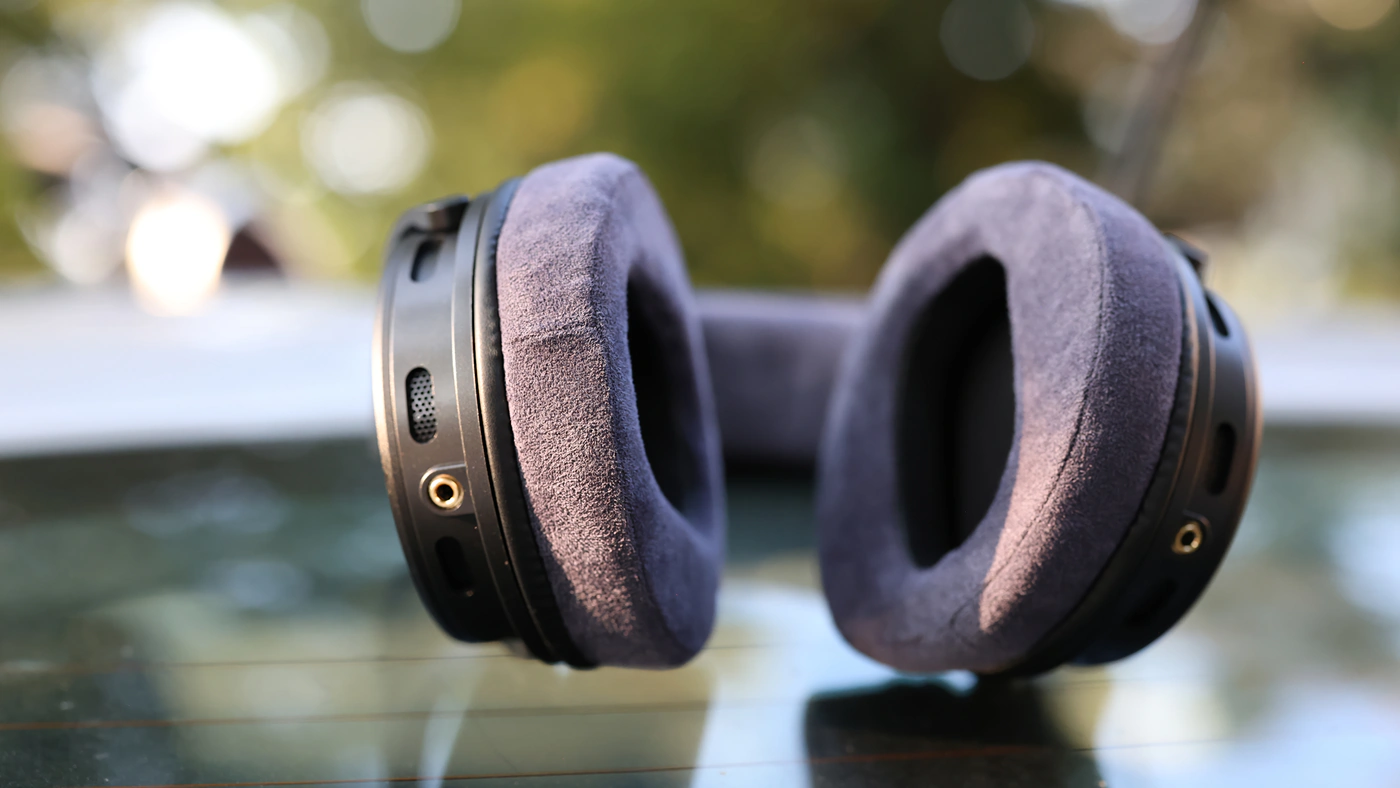
Dynamics / PRaT / Textures – Speaking of decay, the speed of impulse response is rather slow, and this means that music always has a long decay, resulting in a pleasing, somewhat sloppy sound to all instruments. This is desirable for pop, edm and electronic music in general, makes a fun listening experience with a strong impact, but without the fatigue typically associated with this impact. Dynamics are natural, not compressed, while textures also have a bit of influence inherited from the strong bass, so most textures are heavy, thick and bring body to all instruments.
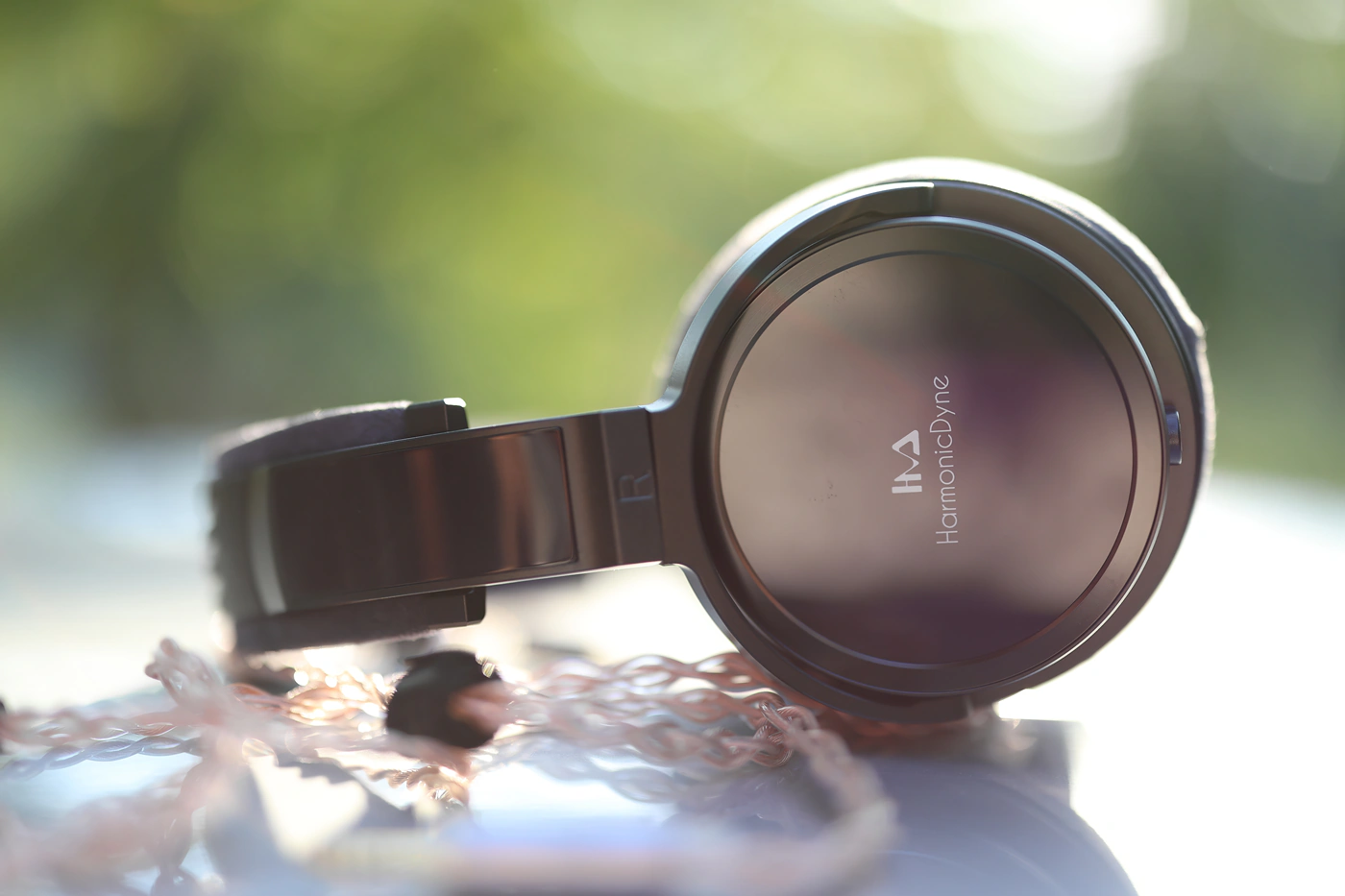
Volume Control – The volume control is very good, and you will hear a clean, and clear sound across all volumes, although the best sonic experience can be had at medium and loud listening volumes. At lower volumes, the bass gets overwhelming and takes the central spot in the sound of the Eris, while at higher volumes there’s more balance between the bass and the midrange, while treble gets louder quickly at very high volumes, giving music a more aggressive and technical edge.
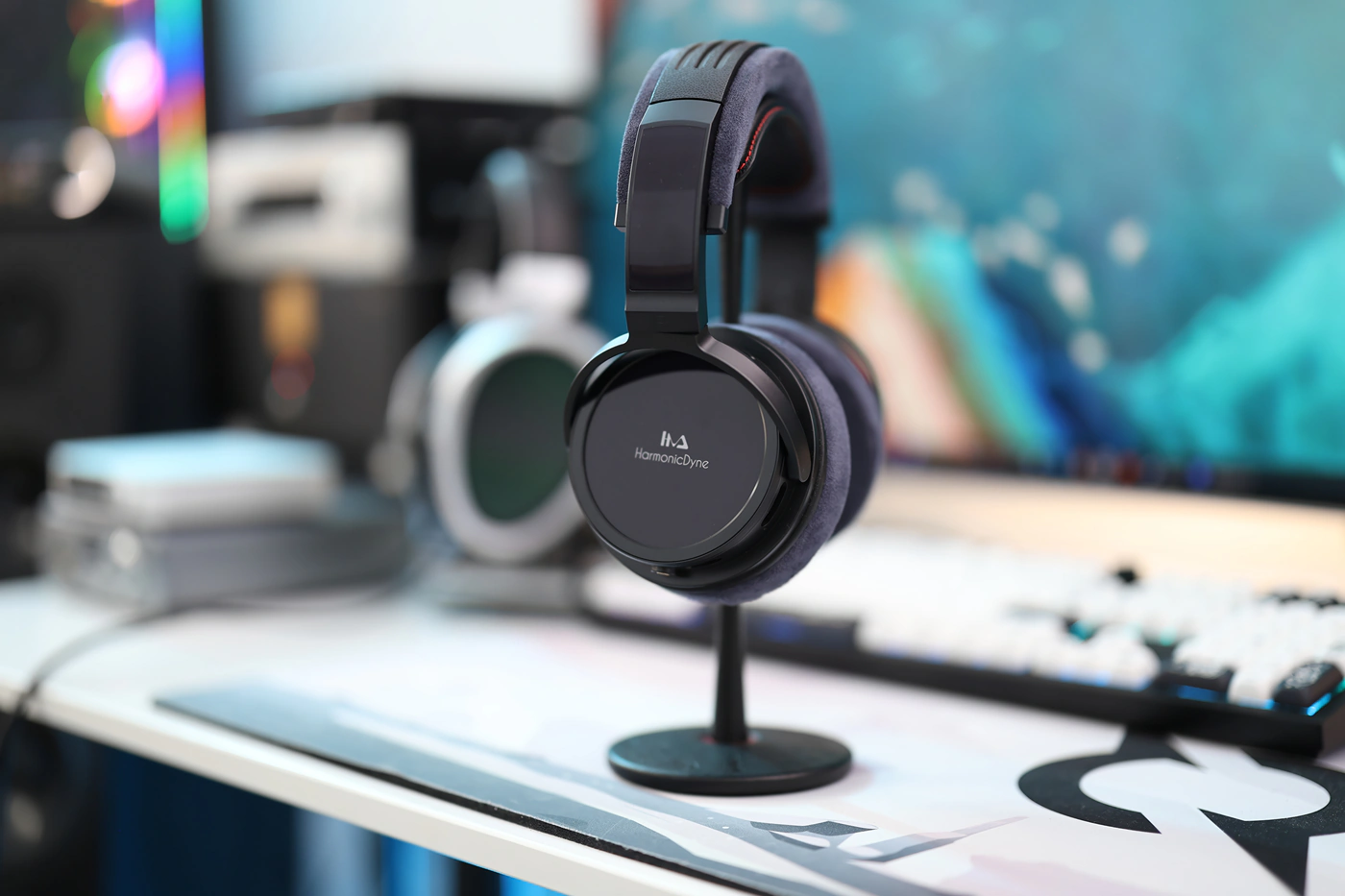
Soundstage – A lot of the design in the Eris has been applied for the sake of creating a wide soundstage, but I knew from the first second that including glass means using a smart reflection mechanism to offer this soundstage, and what eris does is reflect the sound within the earcup, without forcing too much the effect. This means that most people will hear it just fine, and it won’t be as situational as S-Logic is with Ultrasone Signature Pure, but the soundstage has a clear reverb effect to it, and if you listen closely, the approach is audible and once you hear it once, it is always rather evident. This being said, the result is a wide, holographic sound with little distortion, fair precision and imaging.
Comparisons
HarmonicDyne Eris vs Dekoni Cobalt (249 USD vs 399 USD)
Build – The build of the Cobalt is very good in reliability, but they are super light, feeling almost hollow and empty when held in hand. The larger earpads of the Cobalt are more comfortable in contact with my ears, as Eris barely has enough space for my ears in comparison. There is a bit more passive noise isolation to be had with the Cobalt, thanks to their closed-back design, while Eris has a similar degree of leakage. Cobalt is more sensitive to source quality, and source tuning, but it is a bit harder to drive.
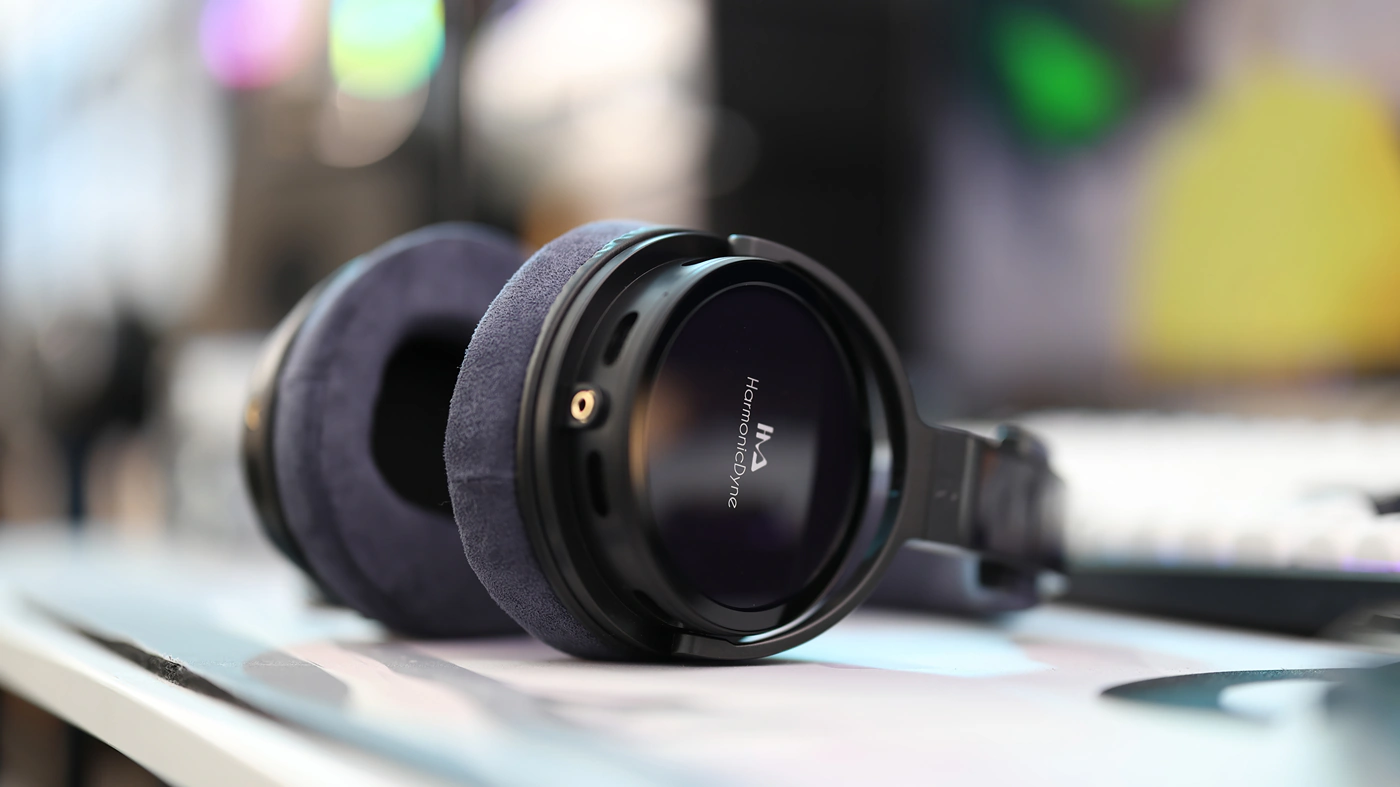
Sound – Despite being harder to drive, Cobalt needs to be listened to at minimum volumes, sounding really bright and revealing, while Eris can be enjoyed at basically any volume, up to ear-bleeding levels, staying enjoyable at all volumes. Cobalt is really bright, sharp and detailed, but quickly gets shouty and fatiguing, while Eris almost never gets fatiguing or harsh, they can be pushed almost infinitely, sounding rather clean and bloomy.
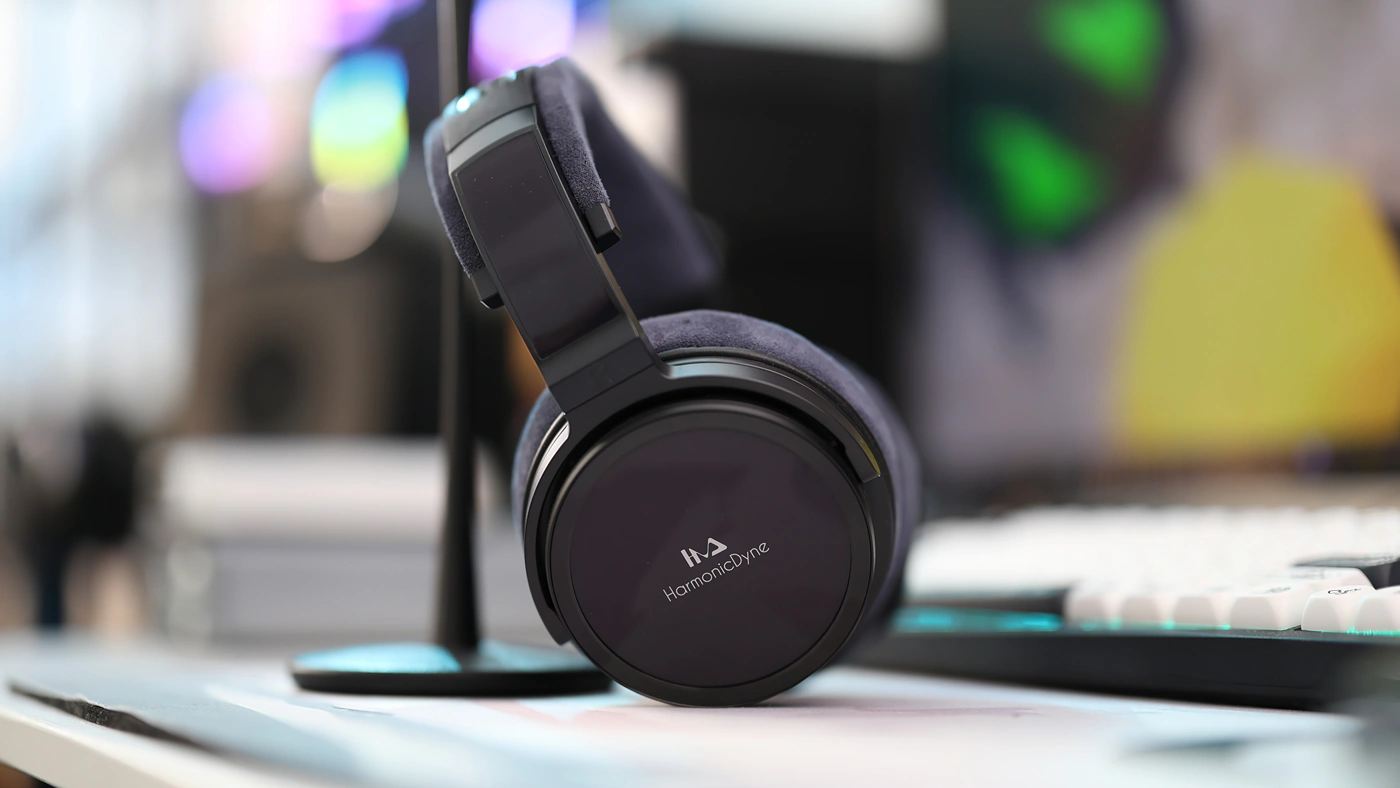
HarmonicDyne Eris vs Sivga Luan (249 USD vs 359 USD)
Build – Siuvga Luan has the comfort to make them feel like the comfiest headphone ever, and the much larger and much softer ear pads surely aid in that. The materials used in the Luan are far better, as they are mainly wood, metal and leather, more secure than the glass and plastic used in Eris, but this also makes the luan a bit heavier and Eris a bit lighter. It is important to never drop the Eris, as the glass could shatter, while Luan can safely take a beating without dying on you. Luan is more sensitive to source quality, more revealing of the source quality and pairs best with a high quality source, while Eris doesn’t really need much power and powers well with most sources too.
Sound – Sivga Luan can be deceiving, as it although it feels comfortable and looks beautiful, it is one of the most surgically precise sounding headphones in the whole world, having a super high resolution, detailed sound and exceptional impact, plus one of the fastest impulse responses out there, sounding bright, razor sharp and detailed, while Eris sounds much bloomier, warmer, thicker, more lush and relaxed, to the point of being extra laid-back in the presentation. Eris will fill your head with bass and sound in general more easily, can be taken louder while Luan is best listened at quiet and medium volumes, as it already reveals more technical detail and does not need a lot of effort to bring it all to you. If you need neutrality, Sivga Luan will be your choice, while if you need warmth, lushness and a pleasing sound, Eris will be happy to deliver it all to you.
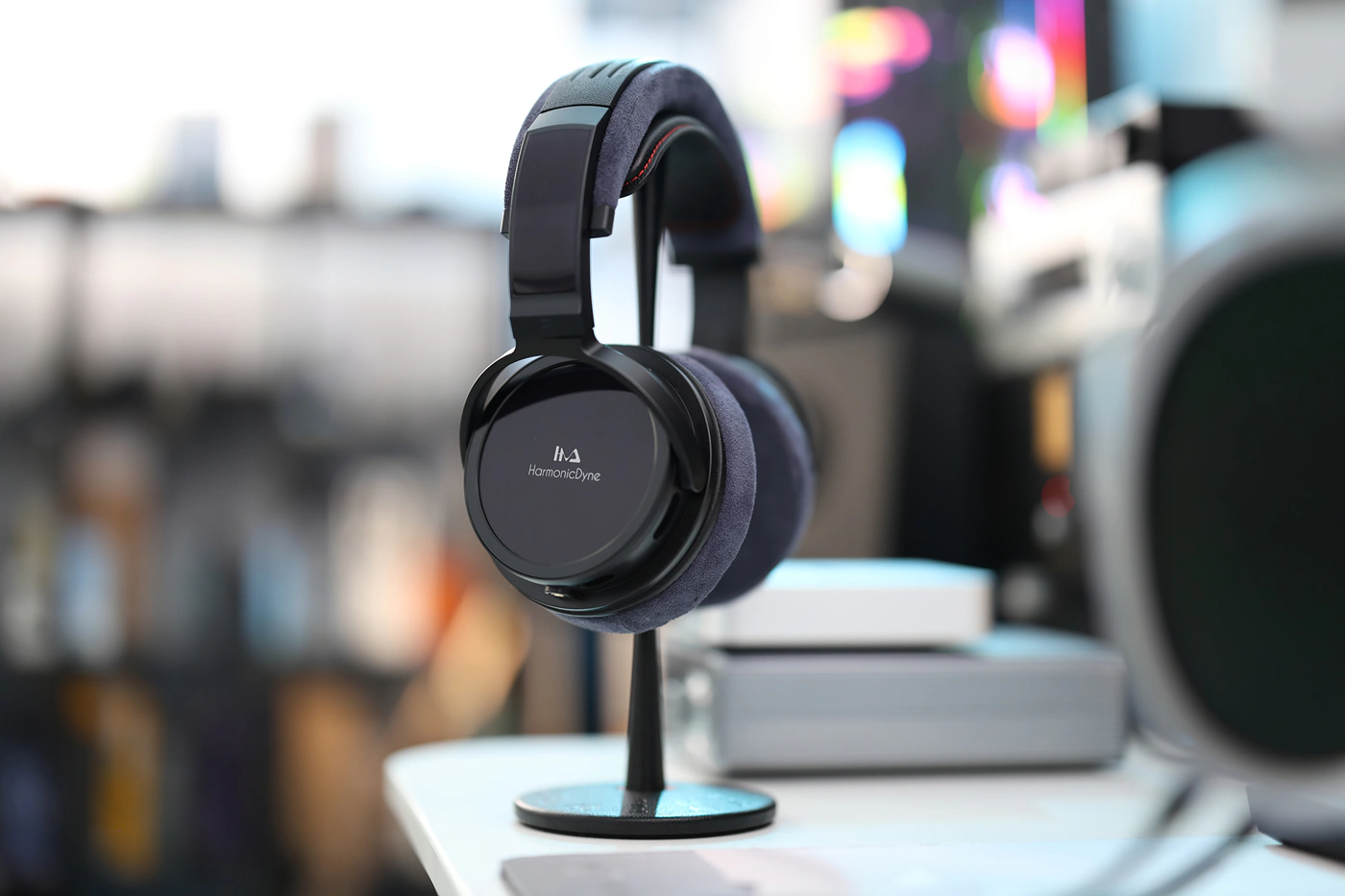
HarmonicDyne Eris vs Aune AR5000 (249 USD vs 299 USD)
Build – Aune aR5000 is super comfortable to the point where comfort is actually one of its highlights. The small difference in weight is not noticeable in practice, but AR5000 uses leather on the outer parts of the earpads, with a velour material on the touch contact part, resulting in a somewhat better comfort for AR5000. On the other hand, AR5000 needs far more power to be driven well, and is more picky with the source, while Eris is far easier to drive and more consistent across sources, not requiring any special features from the source to sound good. The cable of Eris is thicker, more solid and it cancels microphonic noise really well, while the cable of AR5000 is far more basic.
Sound – If you like bass and a darker, thicker sound, Eris will deliver on it really well, while AR5000 sounds airy, atmospheric and relaxed. There’s a big difference between the sweet, slightly intimate and mid centric sound of AR5000 which can be soft, gentle and refined, and the more impactful, boomier and bolder sound of Eris, which is more natural in approach and produces better kick and more sparkle in the treble. AR5000 will be perfect if you like a laid-back, relaxed and lean sounding headphone, while Eris sounds more dynamic, punchy and vivid, better for commercial music, rock, metal and uplifting music in general.
Value and Conclusion
The price of $249 USD almost feels surreal when you take into account the technical performance, package quality, build quality, default cable and everything Eris is able to offer, so value is very high. In fact, this one headphone seems to have almost the best value out of all the HarmonicDyne Headphones and IEMs, except maybe for HarmonicDyne Devil, which may have an even higher price / performance ratio.
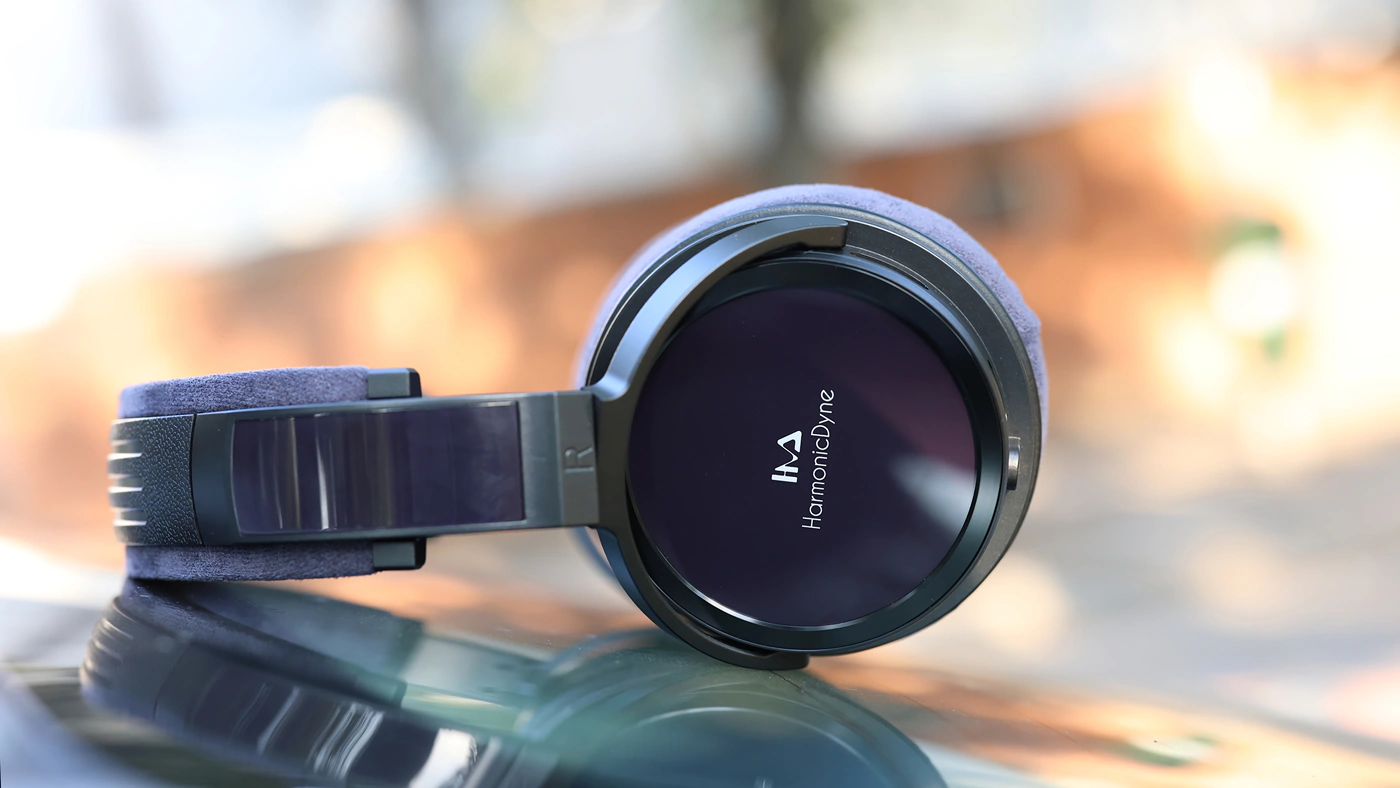
At the end of the day, if you’re looking for a full bass cannon, a pair of beautiful and comfortable headphones with a lightweight design, and a wide soundstage, plus great technicalities, and also likely the best headphone cable you can find at this price point, HarmonicDyne x Z Eris is a fully recommended purchase and a headphone you will have lots of fun with.
Product Link
Amazon – https://amzn.to/3MmLzUr
Aliexpress – https://s.click.aliexpress.com/e/_DFwATUx
--- Please remember to stay safe, and always have fun while listening to music!---
- If you have a dime to spare, please donate, and help us! It would make the day brighter for me and my wife-
Full Playlist used for this review
We listened to more songs than those named in this playlist, but those are excellent for identifying a sonic signature. I recommend trying most of the songs from this playlist, especially if you’re searching for new music! The playlists are different for Spotify, Tidal and Youtube, and based on the songs I enjoy and are available on each!
https://www.youtube.com/playlist?list=PL_cjBXGmwSHSdGcwuc_bKbBDGHL4QvYBu
https://open.spotify.com/playlist/5J3oloz8Riy9LxEGenOjQ0?si=979ba4f082414be7
https://tidal.com/browse/playlist/330fd544-8e5b-4839-bd35-676b2edbb3d5
--- Contact Us ---





